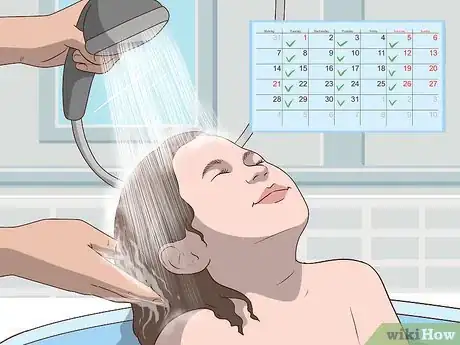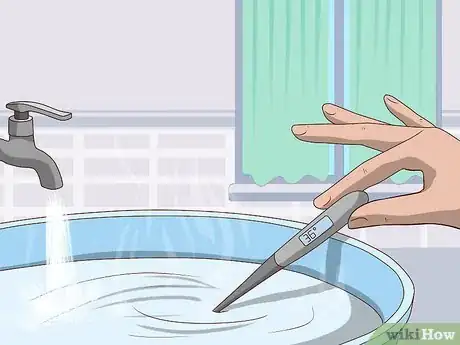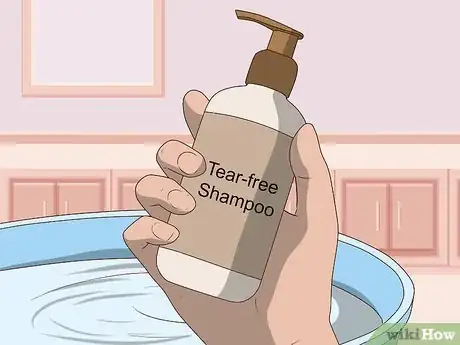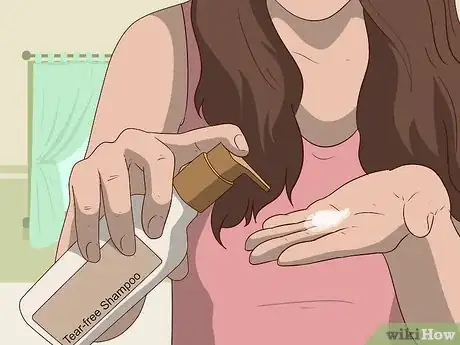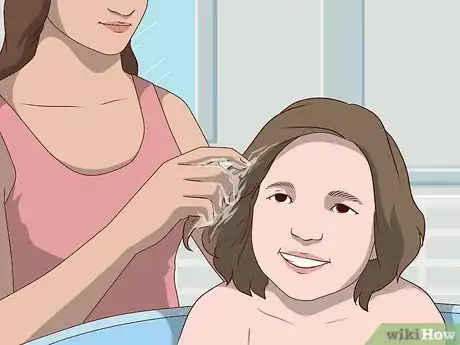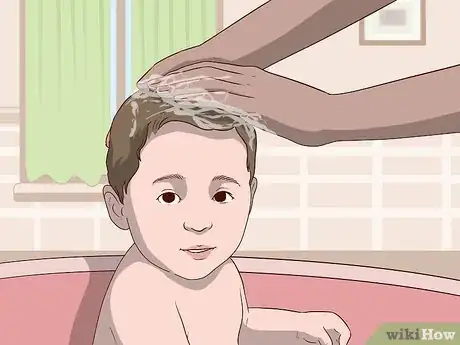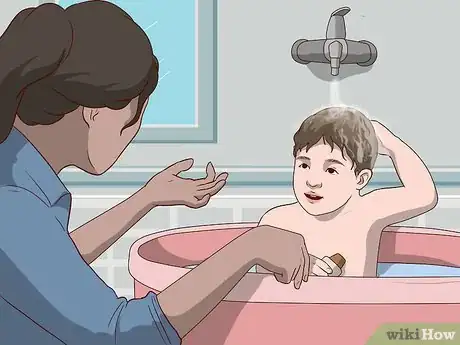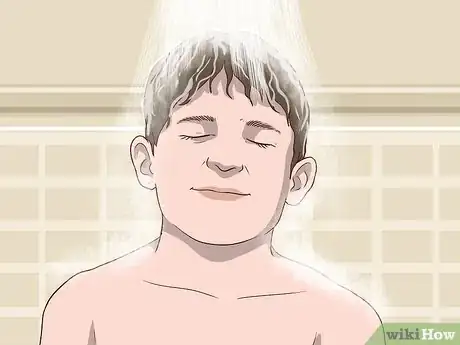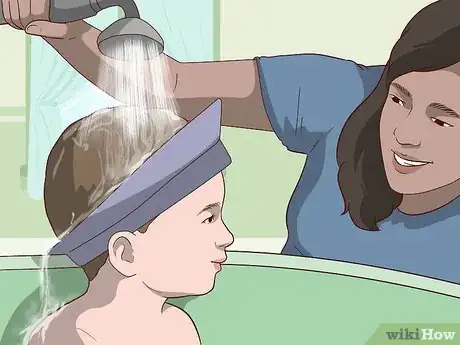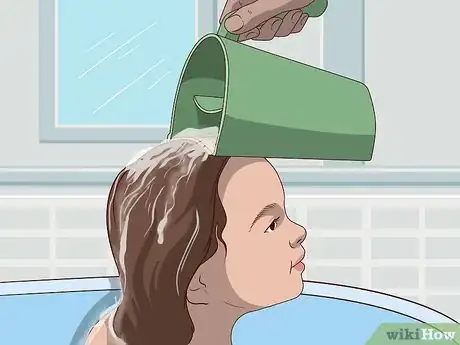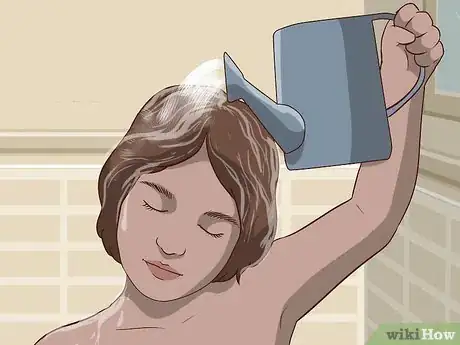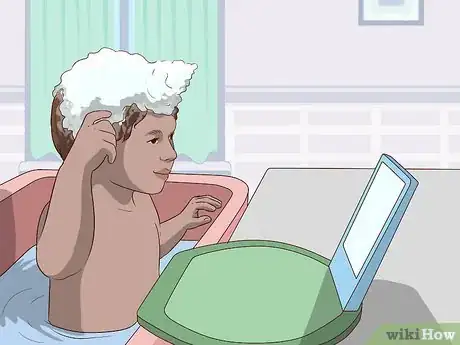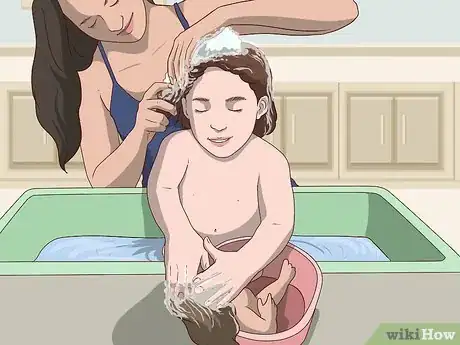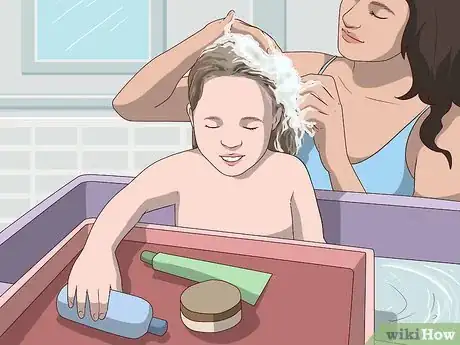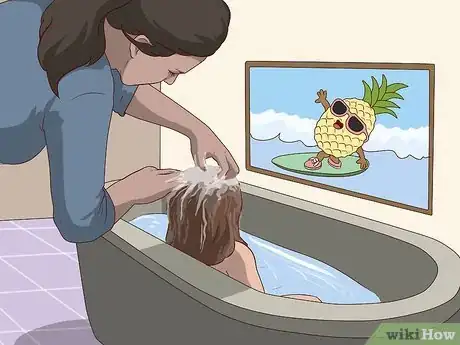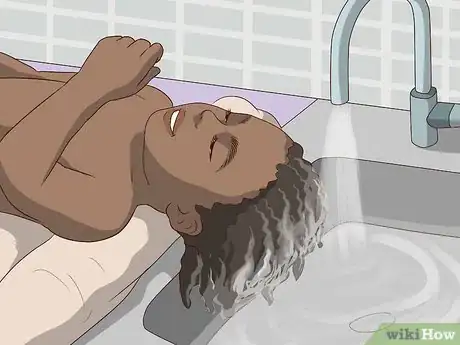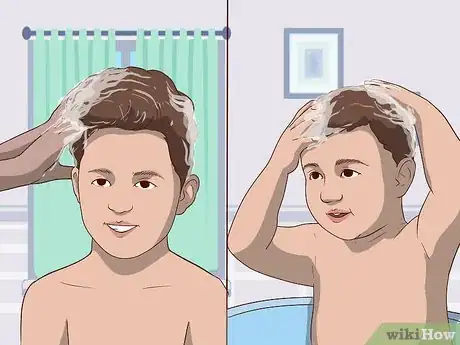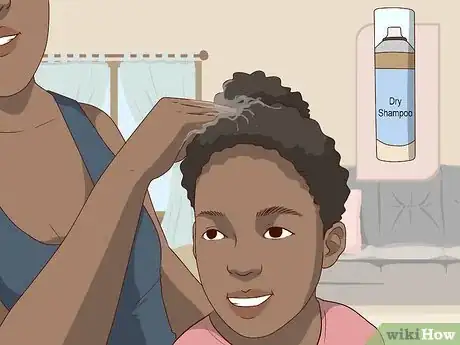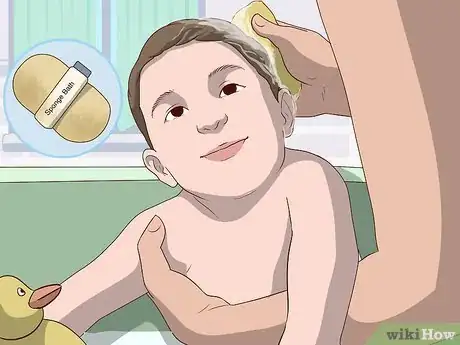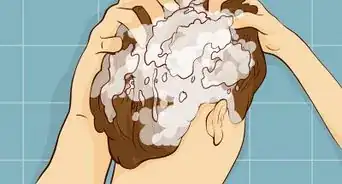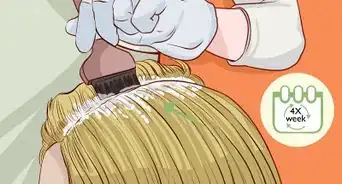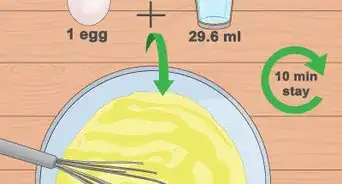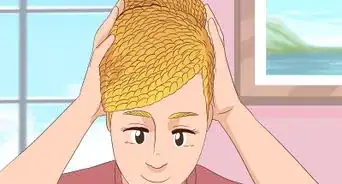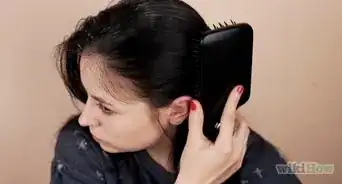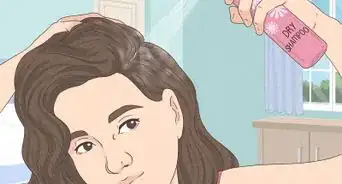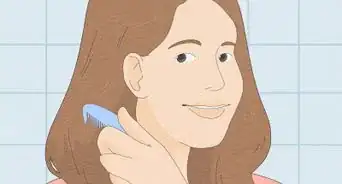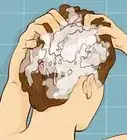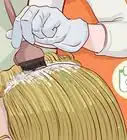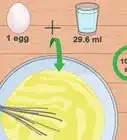This article was co-authored by Denise Stern and by wikiHow staff writer, Janice Tieperman. Denise Stern is a Parenting Specialist and the CEO of Let Mommy Sleep, the country’s leading Baby Nurse and Postpartum Care service. Denise specializes in providing nurturing care to newborns and evidence-based education to their parents. She holds a BA in Public Relations from North Carolina State University. Denise was the US Chamber of Commerce Leading Woman-Owned Business in 2013, a Washington FAMILY Magazine Mother of the Year in 2016, and on the elite White House Summit for Working Families hosted by the President and First Lady Obama in 2014. Let Mommy Sleep is the only company of its kind that holds a local government contract to teach newborn and postpartum care.
There are 7 references cited in this article, which can be found at the bottom of the page.
This article has been viewed 15,272 times.
Hair washing is a necessary process for all young children, but it can be difficult if your child is afraid of water. To keep your child content and comfortable, massage shampoo into their hair instead of pouring it in directly. Next, use a water visor or special pouring cup to rinse the suds out of your toddler’s hair. If the child is nervous or unhappy, try distracting them with fun games and activities! For children with an intense aversion to water, employ some other techniques before, during, and after the bath to reduce their stress levels. With enough time and patience, you’ll be able to develop a routine that’s safe and rewarding for your children!
Steps
Applying the Shampoo
-
1Set a weekly time to wash your toddler’s hair. While you should bathe your child around 3 times per week, you don’t need to wash their hair as often.[1] Instead, pick 1 evening in the week that’s designated for bathtime, and use that time to wash your child‘s hair. Try to slot around 10 minutes for hair washing time, depending on how cooperative your child is.[2]
- Try and stick to whichever schedule you decide on.
-
2Fill the bath with 1 to 3 in (2.5 to 7.6 cm) of warm water. Get the tub ready ahead of time by filling it with a small amount of water.[3] As you’re filling the tub, check your water heater to make sure that the temperature of your bath water doesn’t go above 120 °F (49 °C).[4]Advertisement
-
3
-
4Pour a button-sized amount of shampoo onto your palm. Squeeze a small amount and lather it into a foam in your hands. Avoid pouring the product directly onto the toddler’s head, as this sensation might be overwhelming. Instead, apply the shampoo with your hands, using soft, gentle motions as you rub it in.[7]
- Remember: a small amount of shampoo goes a long way!
-
5Knead the shampoo into the ends of the child’s hair. Pour a button-sized amount of shampoo into your hands and start rubbing it along the ends of the toddler’s hair. Focus specifically on the ends, and rinse them off with warm water before working your way to the upper scalp. For toddlers who dislike the sensation of their hair being rubbed, it might help to wash their hair in stages.[8]
- If your child doesn’t mind having their hair rubbed, feel free to wash all of the shampoo off at once.
-
6Massage shampoo into the top of the toddler’s head. Keep rubbing the product into the child’s hair, working your way up to the roots. Use soft, delicate motions as you continue upwards, working the shampoo into a foamy lather as you go.[9]
Rinsing off the Child
-
1Ask the toddler how they’d prefer to be rinsed off. Take note of your child’s preferences in the bathtub. If they’re old enough to express themselves, ask the toddler if they’d prefer to have water dumped on their head, or if they’d rather be tipped back into a stream of warm water. If you figure out what your child likes ahead of time, you could save yourself a lot of trouble in the long run.[10]
- If your child is uncertain, set the tub faucet to low pressure and help them tip their head back.
- See if older toddlers would prefer to rinse their hair under a shower head.
-
2Remind the child to keep their eyes closed. Reassure the toddler that they won’t feel any soap bubbles in their eyes as long as they keep their eyes shut. Speak to the child in an encouraging tone to soothe them as you prepare to rinse their hair. Don’t proceed until the toddler is calm, and has securely closed their eyes.[11]
-
3Invest in a bath visor if your child doesn’t like getting soaked. Place a bath visor around your toddler’s forehead to prevent any sudsy water from dripping into their eyes. If your child is especially nervous about soap stinging them, see if they’d prefer to wear a visor instead.[12]
- If you don't have a visor, you can shield their eyes with your hand.[13]
-
4Use a special rinsing cup to wash out any shampoo. Purchase a rinsing cup that has an arched spout, which fits well around the circumference of a child’s head. Fill the cup with warm water and pour it slowly, letting the rim rest along the edge of the child’s forehead.[14] Remind the toddler to lean back as you begin rinsing out their hair.[15]
- If your toddler is more independent, let them try pouring the water over their hair.
-
5Let the child rinse themselves off with a watering can. Fill a watering can or teapot with warm water, and invite the toddler to pour the water over their shampooed hair. Guide the child so they pour the water over the center of the scalp, and not in the direction of their eyes.[16]
- The child gets more control over the water pressure when they rinse themselves off.
Warning: Make sure that the water is less than 120 °F (49 °C).[17]
Providing Distractions
-
1Set a mirror at the edge of the bathtub. Place a small, personal mirror near your child so they can see their hair throughout the washing process. Once your toddler’s hair is especially foamy, encourage them to mold their hair into fun shapes, like an animal. If the child is uncertain of what to do, feel free to mold an example in their hair.[18]
- For example, if your child likes dinosaurs, try making a few triceratops spikes with their shampooed hair. If your toddler has a more whimsical mind, try molding their hair into a unicorn’s horn.
-
2Encourage the toddler to wash their doll’s hair. Tell the child to shampoo the hair of their favorite doll. Besides being a distraction, this doll will help teach your child how to wash hair. If the toddler has any difficulty, teach your child how to lather the doll’s hair properly.[19]
- Make sure that you rinse out the doll’s hair and let it dry completely. The last thing you want is for your child’s favorite toy to get moldy!
-
3Play a guessing game with your child to keep them busy. Engage your toddler by asking them to point to different body parts. Start with easy questions, like their head, nose, and tummy. Continue asking fun questions while you wash your child’s hair. If you think of enough questions for your child, you might finish washing your toddler’s hair in the process![20]
Tip: Try playing a game of “I Spy” with your toddler. Give out clues for a certain item in the bathtub area, like a shampoo bottle or bar of soap. Have your child continue guessing until they get the answer right!
-
4Print out a funny picture and place it above the tub. Find an image online that your child will really enjoy, like their favorite cartoon character. Tape this picture to the ceiling of the bathtub, so your child can see it clearly. While your toddler is distracted with the picture, finish shampooing their hair![21]
Minimizing Stress
-
1Let your child rest under a weighted blanket 10 minutes before bathtime. Get your toddler in a more agreeable mood by offering to read them a story before washing their hair. At this time, encourage the child to snuggle under a weighted blanket or play with a weighted toy.[22]
- Weighted blankets and toys can help lessen a child’s anxiety while providing them with comfort.
-
2Try washing your child’s hair in a different location. If your toddler doesn’t like bathing in a tub, move hair washing time to a kitchen sink instead. See if your child prefers washing and rinsing out their hair in a smaller area, and arrange your bathtime schedule from there![23]
- If you use a kitchen sink, make sure that it’s completely clean!
-
3Factor in the child’s preferences and level of independence. Pay attention to what your child likes and doesn’t like about getting their hair washed. If your toddler is older, ask them if they’d like to rub in the shampoo themselves. Make sure that the child gets to play an active role in the hair washing process, or they might not enjoy it as much.[24]
- If your child doesn’t like or is afraid of water, try employing some distractions while you wash their hair.
-
4Opt for a dry shampoo if you want to skip the rinsing process. Pay attention to your child’s preferences—particularly, if they like or dislike water. If your toddler is especially hydrophobic, skip the bathtub altogether and use dry shampoo instead. Hold the can away from the child’s head as you apply a few squirts into their hair.[25]
Did you know? Leave-in conditioners are also great options. While you don’t have to use conditioner, moisturizing products are excellent for your child’s hair.
-
5Go for a sponge bath if your toddler doesn’t like water. Work on getting your child adjusted to the sensation of warm water and soap by giving them a sponge bath. If the idea of a filled bathtub is overwhelming, start with small amounts of water and soap to clean off your toddler, and supplement wet shampoo with a dry alternative. As your child adjusts, start introducing very small amounts of water into the bath.[26]
- When your toddler is in the bathtub, point out all of the fun things that they can do. Enlist the child in a guessing game, or let them play with a toy in the bathtub.
Expert Q&A
-
QuestionWhat do I do if my child is scared of the bath?
 Denise SternDenise Stern is a Parenting Specialist and the CEO of Let Mommy Sleep, the country’s leading Baby Nurse and Postpartum Care service. Denise specializes in providing nurturing care to newborns and evidence-based education to their parents. She holds a BA in Public Relations from North Carolina State University. Denise was the US Chamber of Commerce Leading Woman-Owned Business in 2013, a Washington FAMILY Magazine Mother of the Year in 2016, and on the elite White House Summit for Working Families hosted by the President and First Lady Obama in 2014. Let Mommy Sleep is the only company of its kind that holds a local government contract to teach newborn and postpartum care.
Denise SternDenise Stern is a Parenting Specialist and the CEO of Let Mommy Sleep, the country’s leading Baby Nurse and Postpartum Care service. Denise specializes in providing nurturing care to newborns and evidence-based education to their parents. She holds a BA in Public Relations from North Carolina State University. Denise was the US Chamber of Commerce Leading Woman-Owned Business in 2013, a Washington FAMILY Magazine Mother of the Year in 2016, and on the elite White House Summit for Working Families hosted by the President and First Lady Obama in 2014. Let Mommy Sleep is the only company of its kind that holds a local government contract to teach newborn and postpartum care.
Parenting Specialist Try to shield their eyes with your hand so water and shampoo doesn't run down their face.
Try to shield their eyes with your hand so water and shampoo doesn't run down their face. -
QuestionHow do you use shampoo rinse cups?
 Denise SternDenise Stern is a Parenting Specialist and the CEO of Let Mommy Sleep, the country’s leading Baby Nurse and Postpartum Care service. Denise specializes in providing nurturing care to newborns and evidence-based education to their parents. She holds a BA in Public Relations from North Carolina State University. Denise was the US Chamber of Commerce Leading Woman-Owned Business in 2013, a Washington FAMILY Magazine Mother of the Year in 2016, and on the elite White House Summit for Working Families hosted by the President and First Lady Obama in 2014. Let Mommy Sleep is the only company of its kind that holds a local government contract to teach newborn and postpartum care.
Denise SternDenise Stern is a Parenting Specialist and the CEO of Let Mommy Sleep, the country’s leading Baby Nurse and Postpartum Care service. Denise specializes in providing nurturing care to newborns and evidence-based education to their parents. She holds a BA in Public Relations from North Carolina State University. Denise was the US Chamber of Commerce Leading Woman-Owned Business in 2013, a Washington FAMILY Magazine Mother of the Year in 2016, and on the elite White House Summit for Working Families hosted by the President and First Lady Obama in 2014. Let Mommy Sleep is the only company of its kind that holds a local government contract to teach newborn and postpartum care.
Parenting Specialist Pick a rinse cup that fits the circumference of your child's head. Scoop up clean water, then position it at the front of your child's head so that the water will flow back over the hair. Slowly pour the water over your child's hair to rinse out the shampoo.
Pick a rinse cup that fits the circumference of your child's head. Scoop up clean water, then position it at the front of your child's head so that the water will flow back over the hair. Slowly pour the water over your child's hair to rinse out the shampoo.
References
- ↑ https://chw.org/newshub/stories/coming-clean-about-how-often-kids-need-baths
- ↑ https://www.babycentre.co.uk/a552261/toddler-hair-washing
- ↑ https://www.babycenter.ca/a552261/how-to-wash-your-toddlers-hair
- ↑ https://chw.org/newshub/stories/coming-clean-about-how-often-kids-need-baths
- ↑ Denise Stern. Parenting Specialist. Expert Interview. 19 February 2021
- ↑ https://yourkidstable.com/child-hates-hair-washing/
- ↑ https://www.whattoexpect.com/wom/toddler/15-strategies-to-conquer-your-next-toddler-hair-wash.aspx
- ↑ https://www.whattoexpect.com/wom/toddler/15-strategies-to-conquer-your-next-toddler-hair-wash.aspx
- ↑ https://www.whattoexpect.com/wom/toddler/15-strategies-to-conquer-your-next-toddler-hair-wash.aspx
- ↑ https://yourkidstable.com/child-hates-hair-washing/
- ↑ https://www.whattoexpect.com/wom/toddler/15-strategies-to-conquer-your-next-toddler-hair-wash.aspx
- ↑ https://yourkidstable.com/child-hates-hair-washing/
- ↑ Denise Stern. Parenting Specialist. Expert Interview. 19 February 2021
- ↑ Denise Stern. Parenting Specialist. Expert Interview. 19 February 2021
- ↑ https://www.babycenter.ca/a552261/how-to-wash-your-toddlers-hair
- ↑ https://www.whattoexpect.com/wom/toddler/15-strategies-to-conquer-your-next-toddler-hair-wash.aspx
- ↑ https://chw.org/newshub/stories/coming-clean-about-how-often-kids-need-baths
- ↑ https://www.babycenter.ca/a552261/how-to-wash-your-toddlers-hair
- ↑ https://www.babycenter.ca/a552261/how-to-wash-your-toddlers-hair
- ↑ https://www.babycentre.co.uk/a552261/toddler-hair-washing
- ↑ https://www.babycentre.co.uk/a552261/toddler-hair-washing
- ↑ https://www.whattoexpect.com/wom/toddler/15-strategies-to-conquer-your-next-toddler-hair-wash.aspx
- ↑ https://www.babycentre.co.uk/a552261/toddler-hair-washing
- ↑ https://www.babycenter.ca/a552261/how-to-wash-your-toddlers-hair
- ↑ https://www.whattoexpect.com/wom/toddler/15-strategies-to-conquer-your-next-toddler-hair-wash.aspx
- ↑ https://www.whattoexpect.com/toddler/behavior/resisting-bath-time.aspx
- ↑ https://www.babycenter.ca/a552261/how-to-wash-your-toddlers-hair
- ↑ https://www.babycentre.co.uk/a552261/toddler-hair-washing
